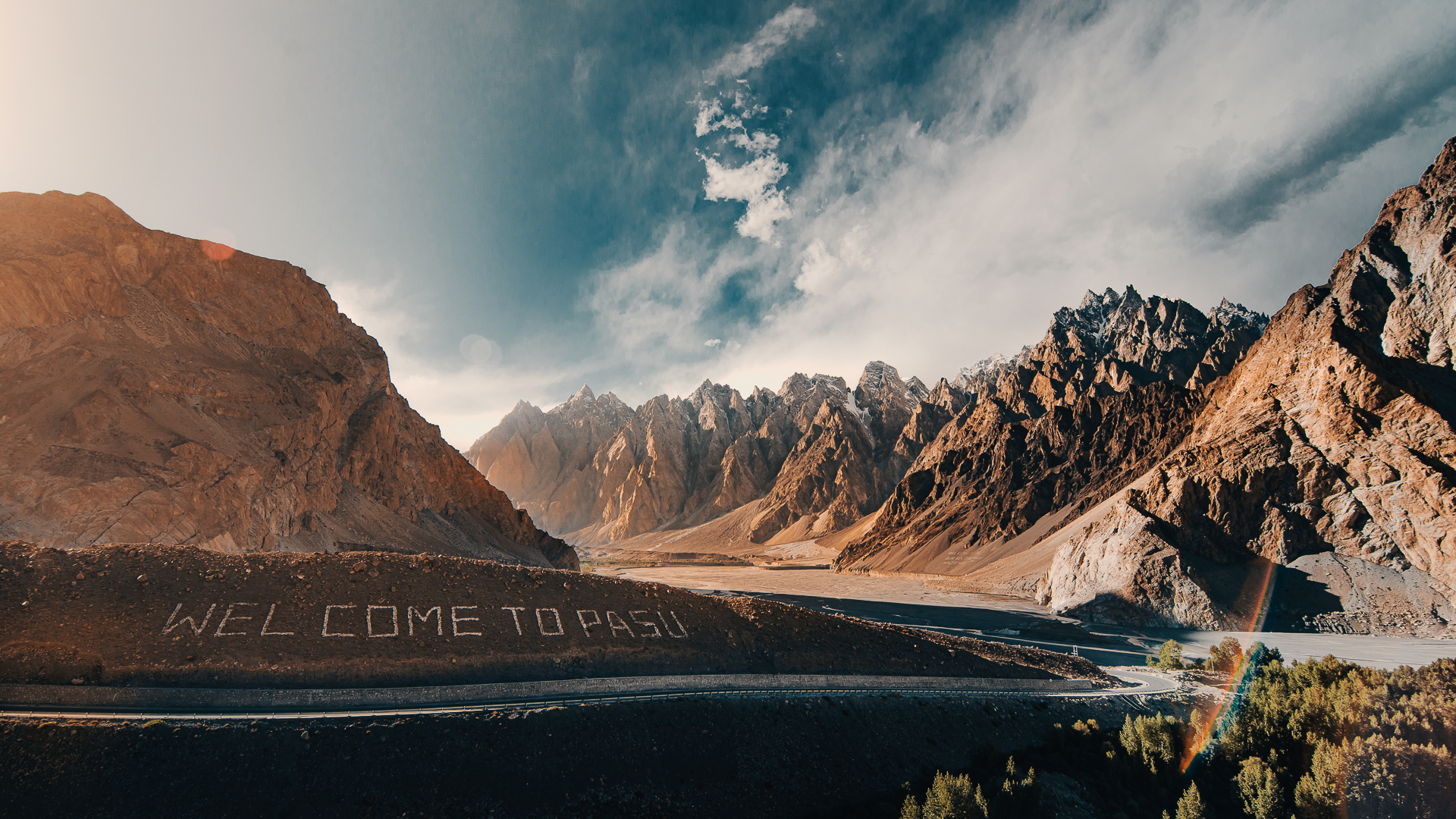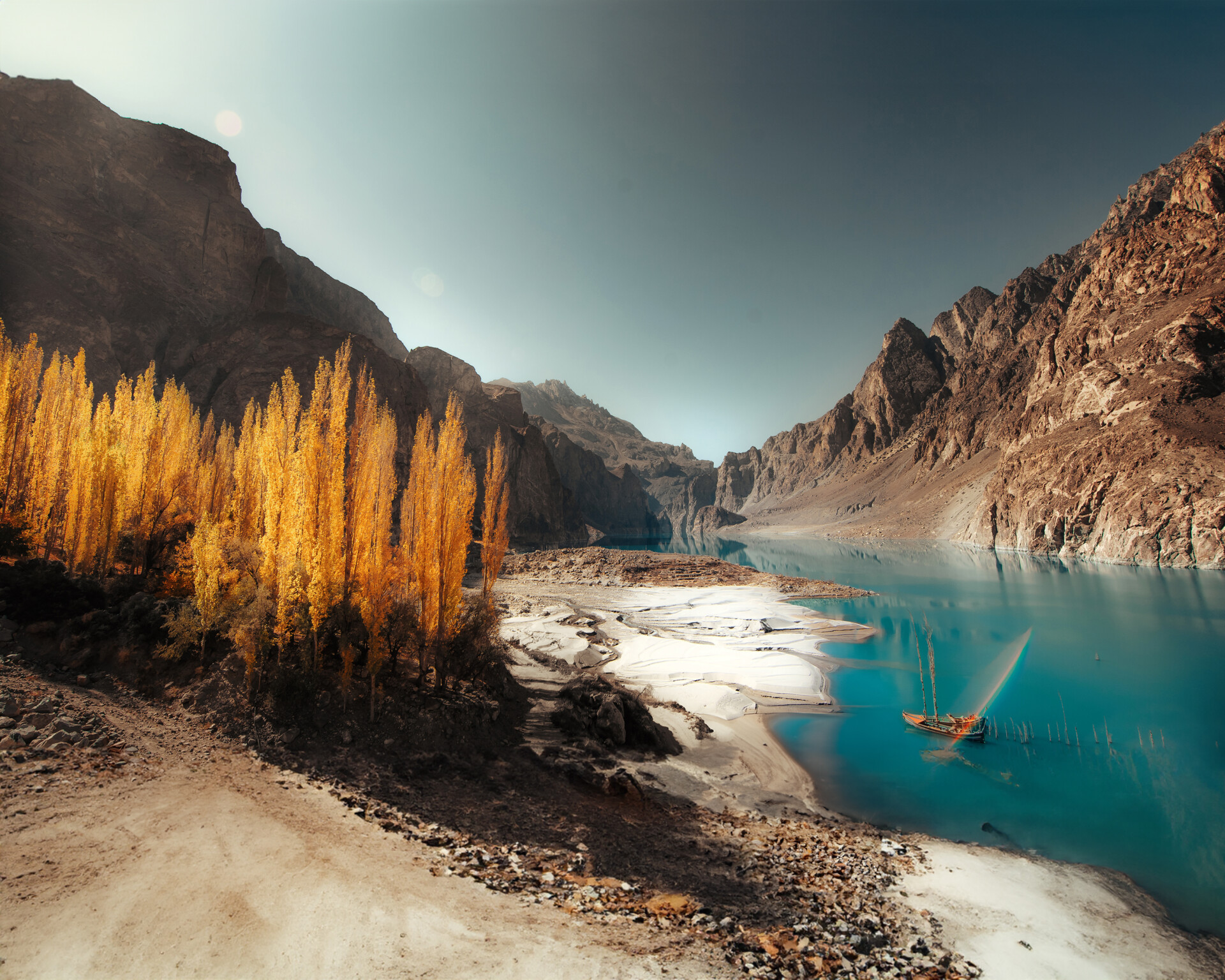As the solid white ice peaks of Passu glacier sprawl down the Karakoram mountains in northern Pakistan, they resemble a row of emperor penguins braving the arctic winds. Wave-like blocks of ice encrusted with a black layer — likely collected from debris, avalanches and rockfalls over the centuries — leap down the mountainside.
The glacier’s melted ice water serves as a source of fresh water, irrigation and hydroelectric power for the mountain communities that live in Hunza Valley, located in the Gilgit-Baltistan region in northern Pakistan, which is part of the larger Kashmir region that has been disputed between Pakistan and India for over seven decades.
A sizable and culturally diverse Shiite and Ismaili Muslim community resides in this region, with some of its members tracing their origins to the Tibetan monks who once lived in the area. Centuries-old wooden carved mosques and Buddhist carvings are all that remain of a Tibetan empire that spread as far as northern Pakistan.
Passu is one of over 7,200 glaciers that dot the region, which is spread across three mountain ranges — the Hindu Kush, the Karakoram and the Himalayas — making Pakistan home to the most glaciers in the world outside of the Arctic and Antarctic. Together, they form the “Third Pole.”
Meltwater from these glaciers across the Karakoram and Western Himalayas provides water to over 300 million people in the Indus River basin, which feeds the world’s largest system of irrigated agriculture, stretching across India and Pakistan. It also feeds rivers that account for about 75% of the stored water supply in Pakistan, a country with a population of over 200 million.
However, as temperatures rise due to climate change, these glaciers, including Passu, are melting rapidly. Over the course of four decades, from 1977 to 2014, Passu glacier became 10% smaller, and it continues to shrink by 4 meters every month, according to research led by multiple climate experts in Pakistan.
In the last decade alone, the glacier has experienced a huge retreat, as seen in satellite images released by the European Union from 2016 to 2024. This is cause for concern because glaciers are not only a source of fresh water, they are life-sustaining for humans, wildlife and even fisheries. Glacial meltwater delivers rich nutrients into oceans, rivers and lakes, impacting levels of phytoplankton (microscopic marine algae), supporting habitats for plants and animals, and providing vital water supplies for people.
“[Glaciers] are natural reservoirs which store water in the form of ice in winter, and release it in summer when it’s a dry season,” explained Sher Muhammad, an expert in glaciology and climate change at the Nepal-based International Centre for Integrated Mountain Development.
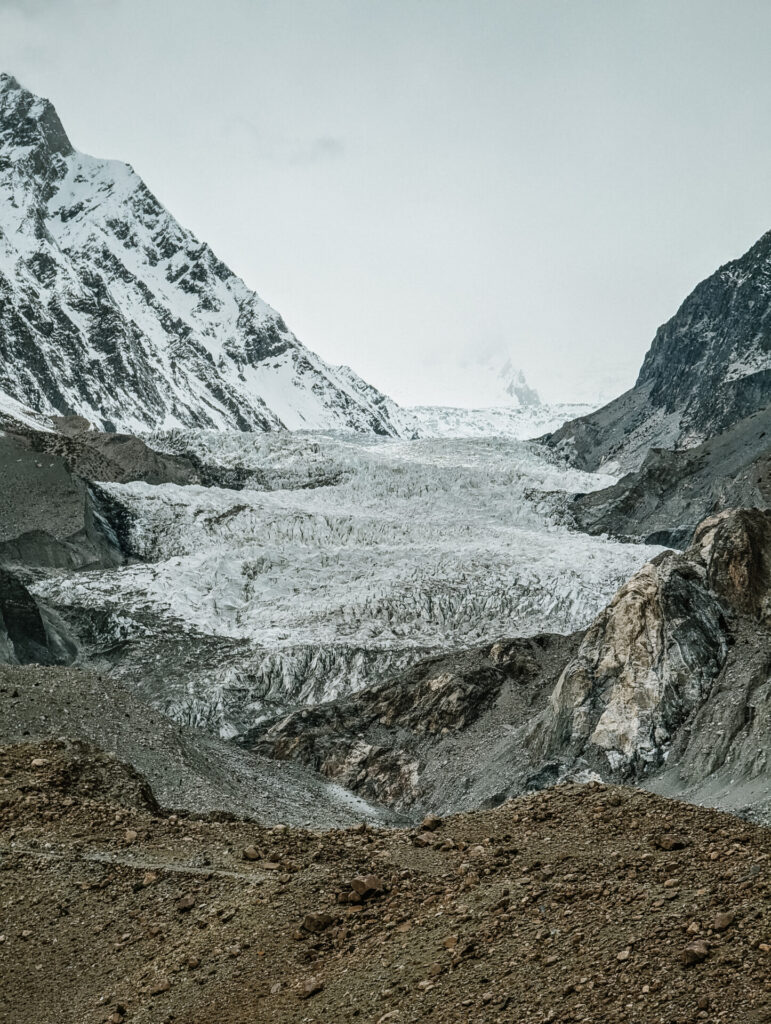
At Glacier Breeze Cafe, which stands at the pinnacle of a hill overlooking the Passu glacier, a slice of apricot cake awaits hikers and mountaineers when cherries, apples and apricots are ripe for picking in the region and mulberry trees turn golden, marking the arrival of autumn.
“When we started our restaurant 20 years ago, we were able to see the Passu glacier from the hotel,” said Israr Ahmed, 35, who was born in Passu village in Gojal Valley below the glacier, and runs this cafe and the adjoining hotel. “Now, you can see a little of the white peaks,” he said, but you can’t see the terminus. The peak of the glacier would once protrude in the shape of a dolphin’s head.
As glaciers melt, they form lakes that may look benign but are unstable and at risk of bursting and causing sudden and catastrophic flash floods, known as “glacial lake outburst floods,” or GLOFs.
Fifteen million people worldwide are at risk of glacial lake flooding according to a study published in Nature Communications, and 2 million of them are in Pakistan.
According to a study by NASA, the volume of glacial lakes worldwide has increased by about 50% since 1990 due to glaciers melting. In Pakistan, a spokesperson for Pakistan’s Ministry of Climate Change said, “Over 3,044 [glacial lakes] have been identified in Gilgit-Baltistan and Khyber Pakhtunkhwa alone… Out of them, 33 lakes have a high probability of bursting.”
Pakistan is among the most vulnerable countries to climate disruption, even though it has historically emitted less than 1% of global carbon emissions. It has borne a disproportionate impact from climate change in recent years.
In 2022, the record-breaking monsoon rains that flooded almost a third of the country killed over 1,700 people and impacted more than 33 million. Torrid heat waves gripped the southern province of Sindh, with temperatures soaring above 52 C (125.6 F) in the summer last year. During the winter months, smog engulfed the northeastern province of Punjab.
Heat waves have rapidly accelerated glacial melt. “These were all agricultural parts,” said Muaziz Karim, a 35-year-old porter from Ghulkin village, close to Passu, gesturing to the absence of vegetation in the surrounding Passu valley. “But now the glacier is going down, water supplies have become too much of a problem.”
Apart from the uncertainty of flash floods, mountain communities also struggle to water their crops in the summers because the glaciers are melting too early. Glaciers typically begin to melt in late spring or early summer. But now they have started melting in early spring.
For two decades, Karim has guided mountaineers and tourists over glaciers and around mountains in Hunza. He is one of around 800,000 people living in north Pakistan’s mountain communities who live within 9 miles of a glacier and are endangered by the risk of flash floods caused by glacial lakes.
Sweeping his hand over the valley, he points to a new glistening silver stream snaking its way to form a glacial lake near Passu village. According to Karim, in July 2007 and April 2008, a glacial lake that had formed at the foot of Passu glacier burst, destroying sections of Passu village and shrinking it to a sliver of fewer than 1,000 people. The rest of the inhabitants became climate refugees scattered across the area.
It is a common tale of woe that haunts the region — the rubble of homes abandoned by their owners because of their proximity to unstable glaciers and rivers that have flooded in the past.
Due to the flash floods, both the landscape and communities are also threatened by landslides.
On the azure surface of Attabad lake — which has recently become a scenic tourist destination lodged between the Karakoram mountains in Hunza — jet skis hurtle across the artificial lake, trumpeting streams of water behind. But 15 years ago, this 13-mile-long lake did not exist.
On Jan. 4, 2010, a massive landslide — one of the biggest in Pakistan’s history — destroyed 26 homes, killed 20 people and displaced around 1,500. But it also blocked the Hunza River, which created the stunning dammed lake that has now become a popular attraction.
However, since the river remains blocked, concerns are rife that the artificial lake could burst without warning.
In the last decade, Pakistan’s northern region has become a burgeoning source of tourism for the country’s ailing economy, where inflation has reached record levels. The ethereal beauty of Pakistan’s towering northern mountainous landscapes — its verdant valleys, cherry blossom groves, winding azure rivers and mountainside waterfalls — has applied a Midas touch to domestic and international tourism.
With a flight time of less than an hour from Islamabad, the country’s capital, and new flights announced in 2024 from Dubai to Skardu, this remote part of Pakistan, which once forced travelers to make a grueling 14-hour drive, is more accessible to tourists and seasoned mountain trekkers from around the world than ever before.
“Because of COVID-19, tourism in Skardu has reached new heights,” said 39-year-old Zakir Satpara. A multi-hyphenated personality, Satpara is a local politician, journalist and guide who drives tourists along the highway from Skardu to Hunza. “Domestic tourists that would have normally gone on holiday in Switzerland and Europe have come to Baltistan instead.”
But plastic pollution and an unfettered property boom have also swept in because of this tourism boom, with consequences for the environment.
The Attabad Lake, with the seismic 2010 landslide almost forgotten, has transformed into a hot spot for hotels with seductive lakeside views. But there is no waste management or sewage facility in the region. As a result, the number of septic tanks and the frequency of illegal dumping in rivers have rocketed.
“You see a landscape that is almost ethereal. At the same time, you see this human activity that is creating degradation and increasing pollution,” said Aisha Khan, who has worked on mountain community restoration programs with locals for two decades. She has witnessed “a sea of change” that has transformed the region in the last decade, where pristine landscapes have metamorphosed into “mismanaged and unregulated hubs of tourism.”
One of the problems is that there is no land-use policy in Pakistan, said Muhammad, the glaciologist expert, referring to regulation of development, management and land-use practices in a particular region — including through zoning, building and construction policies, agriculture measures and natural resources protection.
“This rapid mushrooming of guest houses, hotels, restaurants, and onslaught of tourism beyond the carrying capacity of the land or support services has resulted in environmental degradation of a fragile ecosystem. At this rate, before long, this region too will become like other parts of Pakistan with issues of air pollution and waste management,” Khan said.
“Most of the recently built hotels and resorts use septic tanks for wastewater, including sewage treatment, but due to lack of proper systems and infrastructure in place, most of these tanks tend to overflow, thus polluting adjacent water bodies,” Muhammad said. “There has been contamination, primarily in the form of excess nitrogen and phosphorus nutrients that threaten the aquatic environment by encouraging the growth of algae, endangering fish and other organisms.”
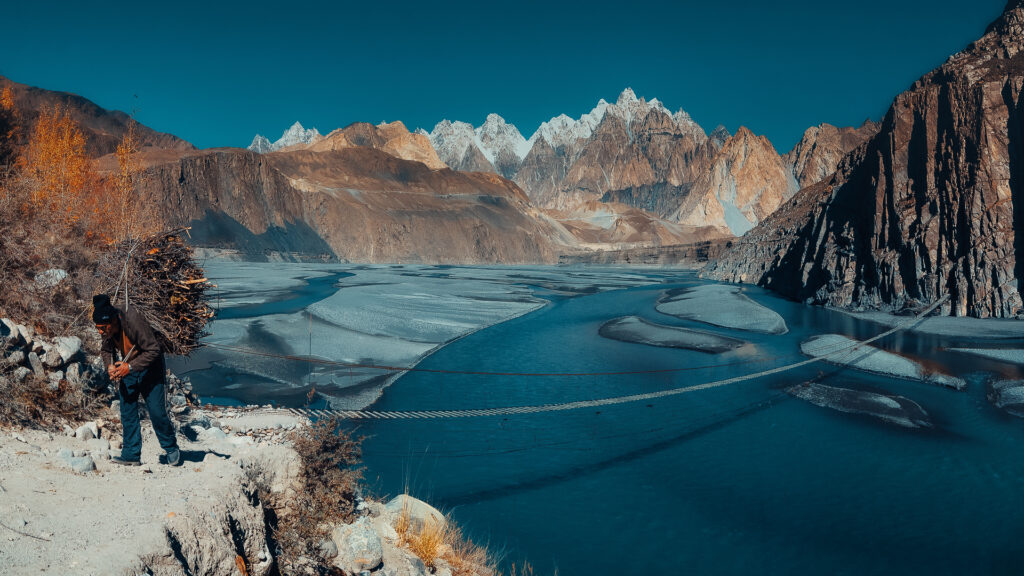
In 2016, Pakistan became one of the first countries to receive adaptation funding from the Green Climate Fund, a key financing pot from the Paris Agreement for projects that help vulnerable communities adapt to climate change through early warning flood systems and other innovations.
A spokesperson for Pakistan’s Ministry of Climate Change told New Lines that the government was funding the construction of infrastructure such as embankments, flood walls and diversion channels in vulnerable areas to channel floodwaters away from populated regions.
However, to mitigate water scarcity caused by rapid glacier melting, some communities here have taken matters into their own hands, turning to local water conservation practices as more sustainable long-term solutions.
One of these practices is called glacier grafting or “mating,” an ancient ritual in Gilgit-Baltistan that combines “male” and “female” glaciers, which are identified according to their color. Villagers carry an ice mass of roughly 80 pounds to higher altitudes, where they cover it with a mixture of mud, ash and charcoal and close the site with heavy stones. Slowly and steadily, the ice mass starts growing in size, as the rate of accumulation (from rainfall, humidity and snow) at these altitudes is greater than the rate of melting and sublimation.
According to local legends, villagers have been using this technique since the 13th century, when they blocked the entry of the Mongol chieftain Genghis Khan and his tribe by growing glaciers in the mountain passes between the Hindu Kush and the Karakoram.
“Glacier grafting is growing or nurturing a baby glacier that will grow automatically in nature,” said Zakir Hussain Zakir, director of academics and outreach at the University of Baltistan Skardu and an expert in the local Balti culture. But the practice has produced varied results because of the time it takes. “According to our tradition, it is said that it will take 12 years to root, and then 12 years to grow up,” Zakir added.
Where snowfall is falling less than usual or where there is a shortage of glacial meltwater, modern techniques such as ice stupas are also being deployed.
Ice stupas are artificial glaciers that store water in geometrically shaped ice cones or stupas that don’t melt until spring. This technique was pioneered in the Ladakh region in India over a decade ago by Sonam Wangchuk, an Indian climate activist and engineer.
“Ice towers are temporary arrangements during the four months of winter when the temperature is below zero,” Zakir said, describing a process where water from springs or valleys is showered into the air to create looming ice towers. “That ice tower later on will give water during the early spring months, which is water shortage time,” he added.
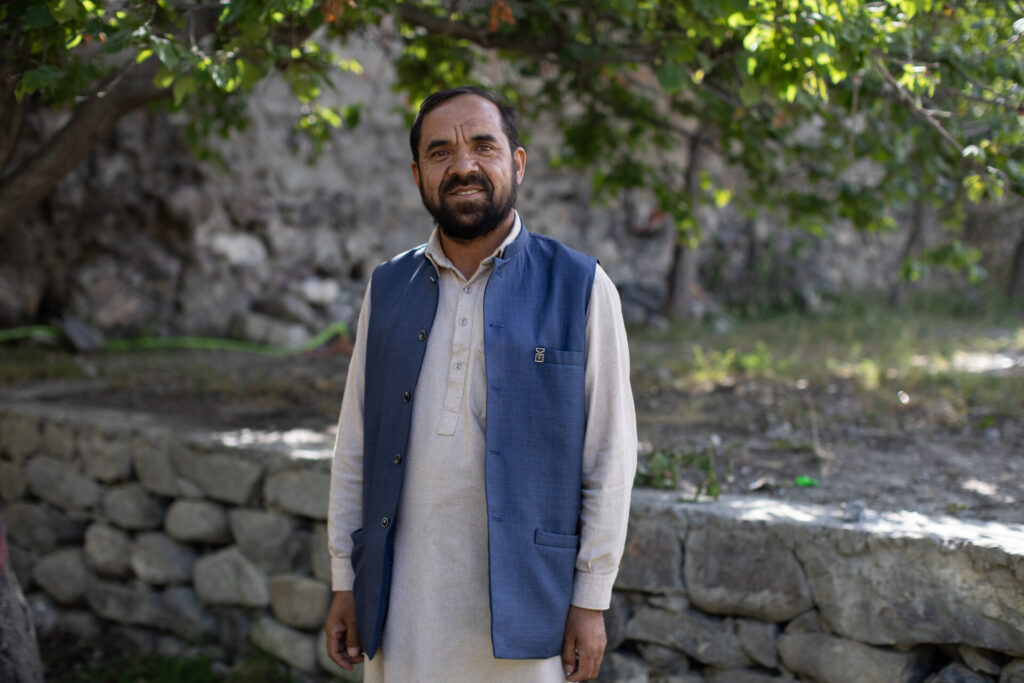
The future of Pakistan’s glaciers is uncertain, even though in the 1990s glaciologists noticed that glaciers in the Karakoram, which straddles the borders of Pakistan, India, Afghanistan, Tajikistan and China, were slowly increasing in size — an unusual behavior that earned the nickname “the Karakoram anomaly.”
But the changes to glaciers in the Hindu Kush Himalayan region driven by global warming are largely irreversible, Muhammad said. “Since then, the glaciers in the Karakoram region have started melting, which indicates that the glaciers in the Karakoram anomaly have ended.”
In June, the International Centre for Integrated Mountain Development reported that snow levels were almost a fifth below normal in the Hindu Kush and Himalayas, the second-lowest snow persistence (which measures the fraction of time snow remains on the ground) on record.
“We will see even less snowfall, which will eventually also affect the health of the glacier. With time, there will be less glaciers and less water available in summer,” Muhammad added. “Governments and policymakers need to reduce carbon emissions so temperature increase is controlled.”
Sign up to our mailing list to receive our stories in your inbox.



